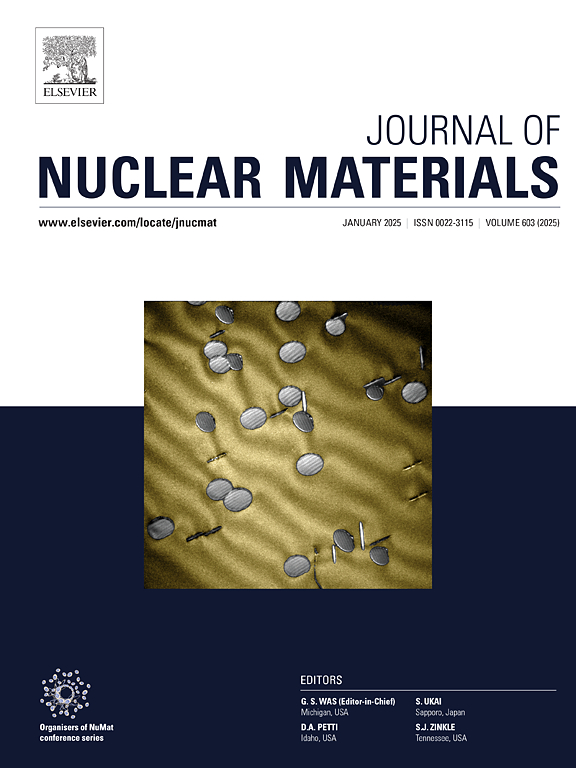cr包覆Zr-1Nb合金在1000 ~ 1200℃蒸汽氧化后的韧脆转变行为及机理
IF 2.8
2区 工程技术
Q3 MATERIALS SCIENCE, MULTIDISCIPLINARY
引用次数: 0
摘要
机械性能,特别是延展性,对于评估cr包覆锆包层在冷却剂损失事故(LOCA)中的安全阈值和极限至关重要。通过135℃单轴拉伸试验,研究了包覆cr的Zr-1Nb合金板材在1000 ~ 1200℃蒸汽氧化后的力学性能,并与未包覆的试样进行了对比。结果表明,氧化温度对cr包覆试样的韧脆转变有显著影响。在1000℃氧化2小时后,cr涂层样品的延展性保持良好,伸长率为16.2%,而未涂层样品的伸长率为0.4%。在1150℃氧化2 h后,cr涂层试样呈现脆性断裂,伸长率为0.2%,抗拉强度降至321 MPa,比氧化前降低18%。韧脆转变与Cr涂层的保护组织演化有关,这在本质上决定了脆性α-Zr(O)在Zr基体中的形成。在1000℃时,Cr涂层良好的氧扩散屏障显著降低α-Zr(O)层的形成。而Cr涂层的加速氧化导致α-Zr(O)相的生成。脆性断裂的临界α-Zr(O)侵入深度约为Zr基体的85%,O和Cr含量分别增加了0.96% (wt.)和1.84% (wt.)。脆性α-Zr(O)的形成主导了延性退化,O和Cr元素向基体扩散也有一定影响。研究结果可以为cr包覆Zr合金在LOCA条件下的性能退化建模提供见解。本文章由计算机程序翻译,如有差异,请以英文原文为准。
Ductile-to-brittle transition behavior and mechanism of Cr-coated Zr-1Nb alloys after 1000–1200 °C steam oxidation
Mechanical properties, particularly ductility, are crucial for evaluating the safety threshold and limits of Cr-coated zirconium claddings at loss of coolant accident (LOCA). The mechanical properties of Cr-coated Zr-1Nb alloy plates after 1000–1200 °C steam oxidation are investigated through uniaxial tensile tests at 135 °C, with uncoated specimens as comparison. The results show that the ductile-to-brittle transition of Cr-coated samples is significantly affected by oxidation temperatures. After 2 h oxidation at 1000 °C, Cr-coated samples remain good ductile with 16.2 % elongation compared to 0.4 % for uncoated ones. While, Cr-coated samples exhibit brittle fracture with 0.2 % elongation after 2 h oxidation at 1150 °C, and the tensile strength diminishes to 321 MPa, a reduction of 18 % compared to before oxidation. The ductile-to-brittle transition is associated with the protective structure evolution of Cr coating, which essentially determines the formation of brittle α-Zr(O) in Zr substrate. At 1000 °C, good oxygen diffusion barrier of Cr coating significantly reduces α-Zr(O) layer formation. However, accelerated oxidation of Cr coating results in the generation of α-Zr(O) phase. The critical α-Zr(O) intrusion depth for brittle fracture is about 85 % of Zr substrate, and the content of O and Cr increased by 0.96 % (wt.) and 1.84 % (wt.), respectively. Formation of brittle α-Zr(O) dominates the ductility degradation, and O and Cr element diffusion into substrate also have a certain effect. The findings can provide insights for performance degradation modeling of Cr-coated Zr alloys under LOCA conditions.
求助全文
通过发布文献求助,成功后即可免费获取论文全文。
去求助
来源期刊

Journal of Nuclear Materials
工程技术-材料科学:综合
CiteScore
5.70
自引率
25.80%
发文量
601
审稿时长
63 days
期刊介绍:
The Journal of Nuclear Materials publishes high quality papers in materials research for nuclear applications, primarily fission reactors, fusion reactors, and similar environments including radiation areas of charged particle accelerators. Both original research and critical review papers covering experimental, theoretical, and computational aspects of either fundamental or applied nature are welcome.
The breadth of the field is such that a wide range of processes and properties in the field of materials science and engineering is of interest to the readership, spanning atom-scale processes, microstructures, thermodynamics, mechanical properties, physical properties, and corrosion, for example.
Topics covered by JNM
Fission reactor materials, including fuels, cladding, core structures, pressure vessels, coolant interactions with materials, moderator and control components, fission product behavior.
Materials aspects of the entire fuel cycle.
Materials aspects of the actinides and their compounds.
Performance of nuclear waste materials; materials aspects of the immobilization of wastes.
Fusion reactor materials, including first walls, blankets, insulators and magnets.
Neutron and charged particle radiation effects in materials, including defects, transmutations, microstructures, phase changes and macroscopic properties.
Interaction of plasmas, ion beams, electron beams and electromagnetic radiation with materials relevant to nuclear systems.
 求助内容:
求助内容: 应助结果提醒方式:
应助结果提醒方式:


